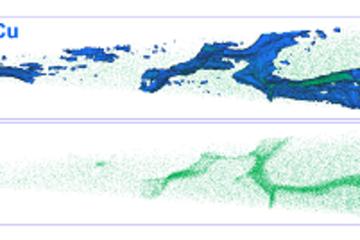All genres
1.
Journal Article
Steric and Chain Length Effects in the (√(3) x √(3))R30°Structures of Alkanethiol Self-Assembled Monolayers on Au(111). ChemPhysChem 12, pp. 999 - 1009 (2011)
2.
Journal Article
Comparison of Adsorption of Mercaptopropyltrimethoxysilane on Amphiphilic TiO2 and Hydroxylated SiO2. Langmuir 26 (19), pp. 15161 - 15168 (2010)
3.
Journal Article
The Role of Gold Adatoms in Self-Assembled Monolayers of Thiol on Au(111). Sp. Iss. SI, pp. 3466 - 3472 (2009)
4.
Journal Article
Mechanism for phase transitions and vacancy island formation in alkylthiol/Au(111)self-assembled monolayers based on adatom and vacancy-induced reconstructions. Physical Review B 79 (7), pp. 075440-1 - 075440-6 (2009)
5.
Talk
High density structures of ethyl-thiol SAM´s on Au(111): A DFT study. SurMat Seminar, Schloß Gnadenthal, Kleve, Germany (2008)
6.
Talk
The Role of Gold Adatoms in Self-Assembled Monolayers of Thiol on Au(111). 6th Congress of the International Society for Theoretical Chemical Physics, ISTCP-VI, University of British Columbia, Vancouver, Canada (2008)
7.
Talk
Modelling adhesion and delamination at oxide/polymer interfaces. Multiscale Material Modeling of Condensed Matter, MMM2007, St. Feliu de Guixols, Spain (2007)
8.
Talk
Combining Monte Carlo Kinetics and Density Functional Theory to simulate Temperature Programmed Desorption. American Vacuum Society 54th International Symposium, Seattle, WA, USA (2007)
9.
Talk
Oxygen Reduction at Thiol/Au(111)SAMs, Atomistic Modelling and Experiment. 212th ECS Meeting, Washington, D.C., USA (2007)
10.
Talk
Degradation of Alkanethiol/Au(111) Self-Assembled Monolayers During Oxygen Reduction. 1. Harzer Ab initio Workshop, Clausthal-Zellerfeld, Germany (2006)
11.
Talk
A DFT study of Alkanethiol adsorption sites on Au(111) surfaces. A DFT study of Alkanethiol adsorption sites on Au(111) surfaces, Clausthal, Germany (2006)
12.
Poster
A DFT study of Alkanethiol adsorption sites on Au(111) surfaces. 2nd IMPRS-SurMat Workshop in Surface and Interface Engineering in Advanced Materials, Ruhr-Universität Bochum, Bochum, Germany (2008)
13.
Poster
Cathodic Delamination by a Combined Computational and Experimental Approach: The Aklylthiol/Gold Model System. Multiscale Material Modeling of Condensed Matter, MMM2007, St. Feliu de Guixols, Spain (2007)
14.
Poster
Oxygen Reduction at Thiol SAMs on Au (111) – A Combined Experimental and Modelling Approach. The 210th Meeting of The Electrochemical Society, Cancun, Mexico (2006)
15.
Thesis - PhD
DFT Study of Alkanethiol Self-assembled Monolayers on Gold(111) Surfaces. Dissertation, Ruhr-Universität-Bochum, Fakultät für Physik und Astronomie, Bochum, Germany (2009)











